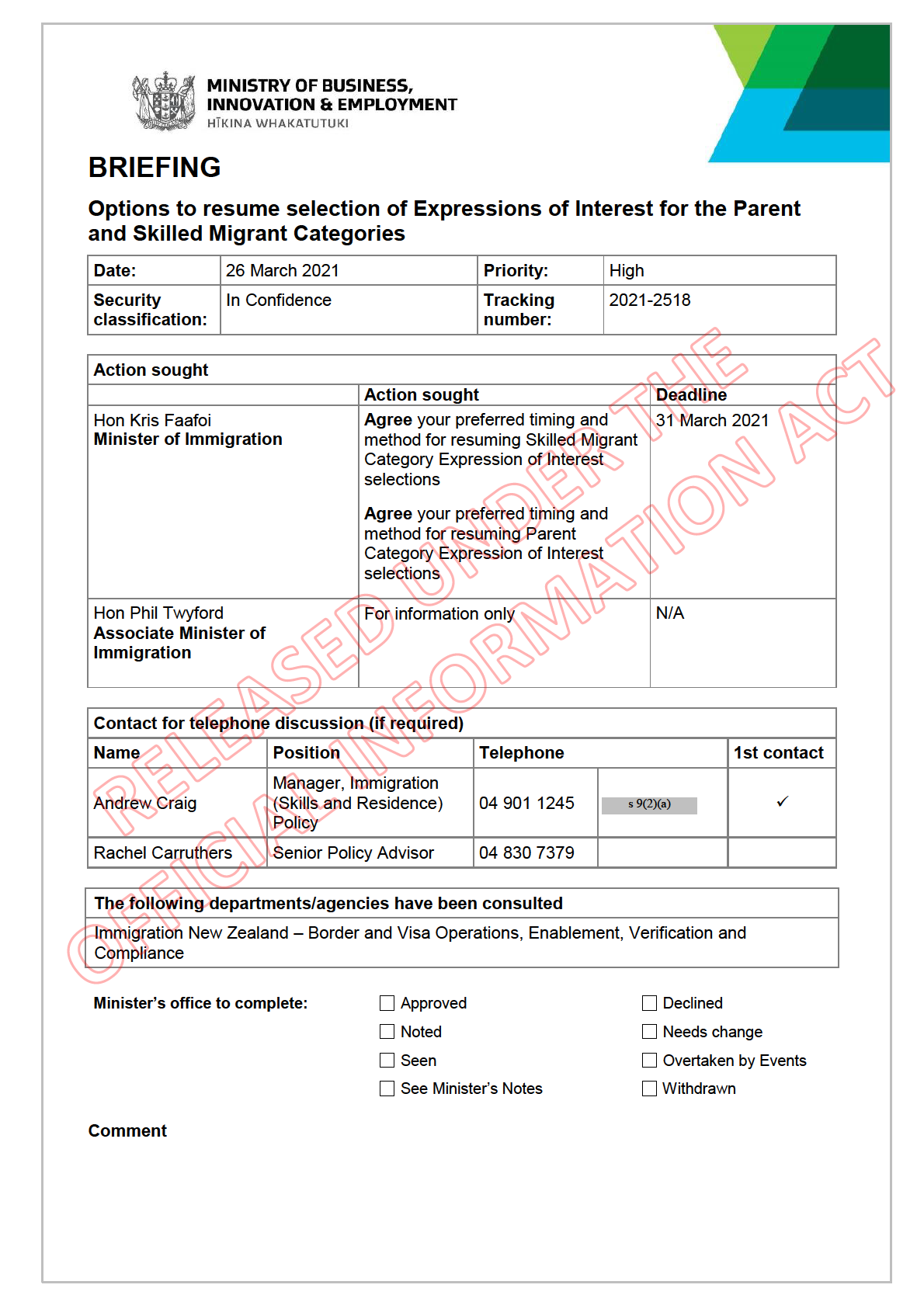

 BRIEFING
Options to resume selection of Expressions of Interest for the Parent
BRIEFING
Options to resume selection of Expressions of Interest for the Parent
and Skilled Migrant Categories
Date:
26 March 2021
Priority:
High
Security
In Confidence
Tracking
2021-2518
classification:
number:
Purpose
To provide you with options and advice on resuming selections of Expressions of Interest
(EOIs) for the Parent and Skilled Migrant residence visa categories, which have been
suspended since 2016 and 2020 respectively, and
To inform you of implications of resuming selection of EOIs on application processing
timelines, and presenting high-level options for clearing the queue faster.
Executive summary
The selection of EOIs for the Skilled Migrant Category (SMC) was suspended in April 2020 due to
COVID-19-related limitations. The selection of Parent EOIs was suspended in 2016 to facilitate
policy changes and has not yet resumed.
The ongoing suspension of EOI selection for these categories runs until late March 2021, and a
decision is now needed on whether to extend the suspension or resume the selection of EOIs.
In developing advice on when and how to resume EOI selections, officials have considered:
the labour market need, to both retain highly skilled people and ensure that any changes do
not inadvertently disadvantage applicants who fill critical roles
the need to provide certainty for those who have submitted EOIs, who have been waiting
months (or years for many in the Parent Category) in the EOI queue and may have delayed
important life decisions (e.g. starting a family, entering university) pending the outcome of
their EOI
Immigration New Zealand’s (INZ) capacity to implement proposed changes, and the scale
of trade-offs in resourcing and service delivery required to deliver different options, and
alignment with future direction for immigration policy over this parliamentary term.
Officials recommend you resume selection of the Skilled Migrant Category EOIs as soon as
is practicable. INZ has the capacity to resume processing, and while selections remain
suspended, people with EOIs in the queue face significant uncertainty and may be delaying
important life decisions owing to these visa-related delays.
Officials recommend you increase the eligibility points threshold from 160 to 180, to apply to
both new EOIs being submitted and those on-hand. Raising the points is desirable to manage
future demand for the SMC. A 20-point increase to the threshold will:
support this Government’s labour market objectives by benefiting higher-skilled applicants
reduce the volume of lower-skilled applicants to the SMC, including the number of new
EOIs submitted and EOIs on-hand that will need to be processed. There is a known issue
with applications from lower-skilled applicants clustering around the minimum points
threshold, and
2021-2518
In Confidence
1
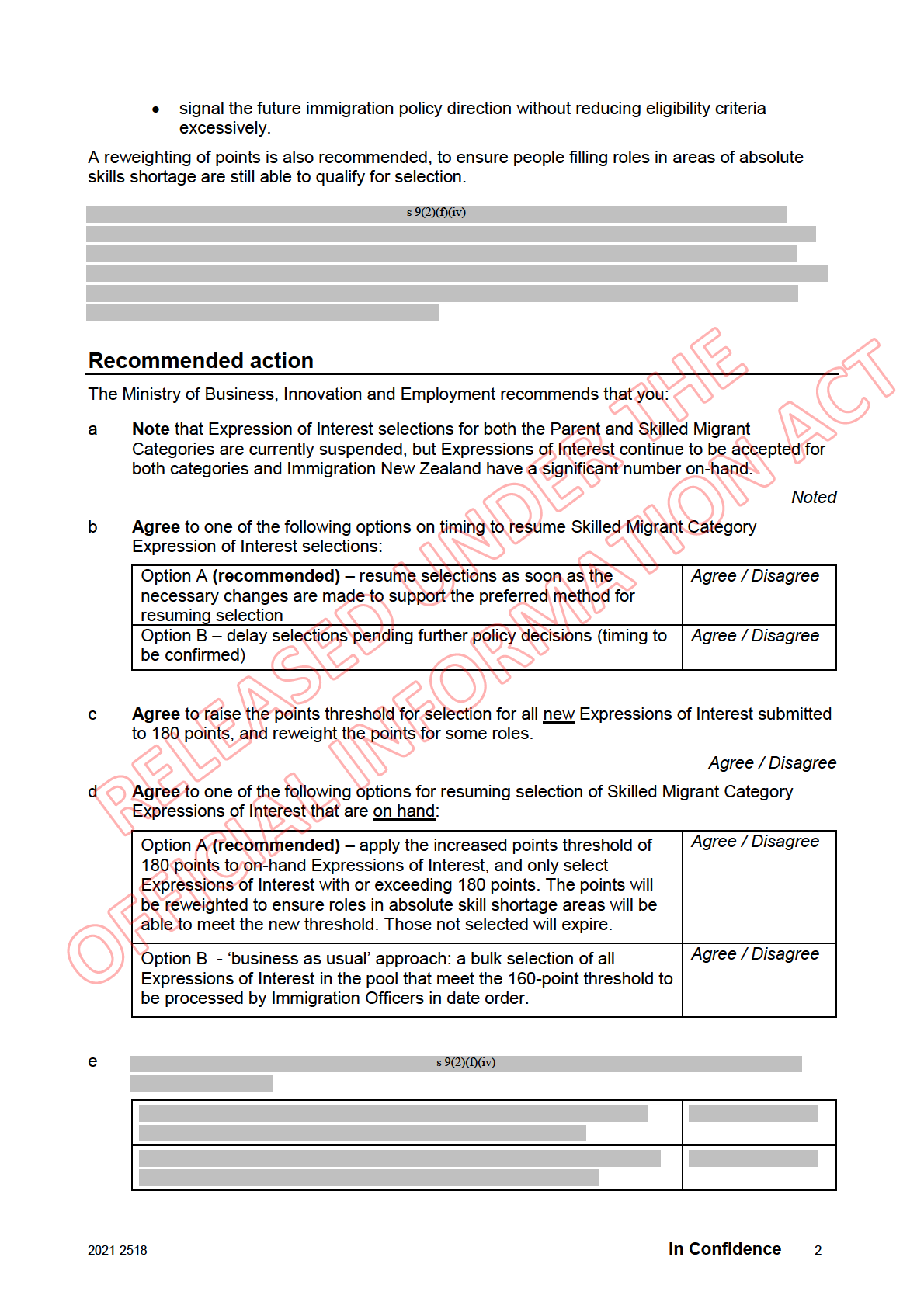

f
s 9(2)(f)(iv)
g
Note that options in recommendation d) and e) have resourcing and potentially financial
implications for Immigration New Zealand.
Noted
h
Note that three options have been identified for resourcing:
i.
Business as usual
ii.
Reprioritisation of existing resources
iii.
Upscaling resources (i.e. bring on additional surge resourcing)
Noted
i
Note that you have previously indicated publicly that you will be taking a decision on this
matter by the end of March 2021.
Noted
j
Agree to discuss the contents of this paper with officials.
Agree / Disagree
Andrew Craig
Hon Kris Faafoi
Manager, Immigration Policy
Minister of Immigration
(Skills and Residence)
Labour, Science and Enterprise, MBIE
..... / ...... / ......
..... / ...... / ......
2021-2518
In Confidence
3
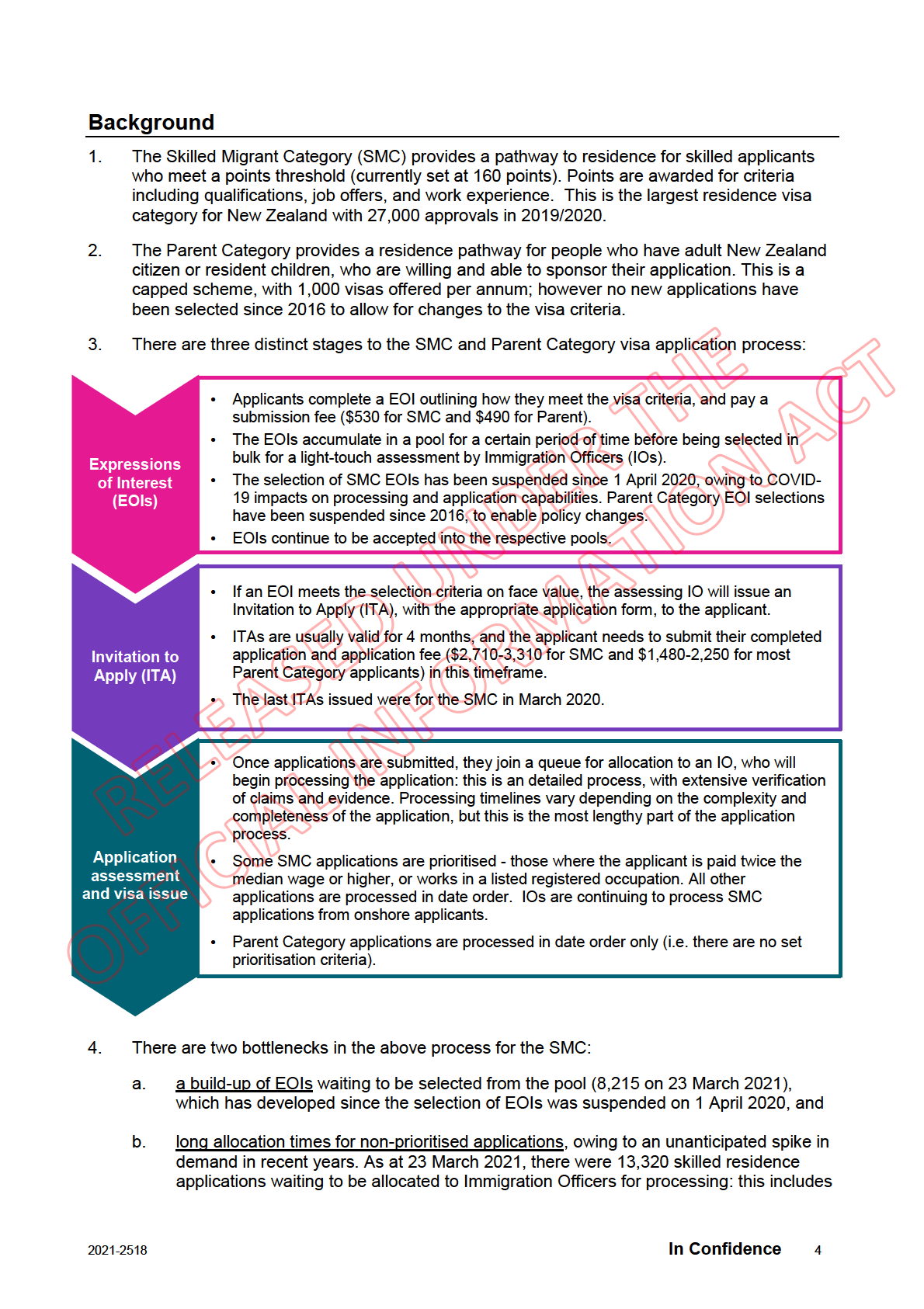

SMC and Residence from Work (RfW) applications, which are processed by the same
team. Of these, 11,711 are from onshore applicants, and 1,609 are from offshore
applicants. The wait time for allocation of non-prioritised application to an IO for
assessment is up to two years, although prioritised applications are allocated within two
weeks of entering the priority list. INZ is currently not processing offshore applications
and is allocating non-prioritised applications received in August 2019.
5.
For the Parent Category, there is a build-up at the EOI stage, as EOIs have not been
selected since 2016 as a consequence of suspension of the policy. There is a large queue of
EOIs (5,376 applications, with the oldest dating from 2012), which will take years to process
given the cap of 1,000 visas issued per annum. Changes to this cap are not considered in
this paper.
6.
EOI selection for SMC was suspended in April 2020 due to COVID-19-related processing
limitations. Parent Category EOI selections were due to resume in May 2020, but this was
postponed due to processing limitations. The suspension and postponement were extended
until late March 2021, and a decision is now needed on whether to extend the suspension or
resume selection of EOIs.
7.
Immigration New Zealand (INZ) now has capacity to resume EOI processing meaning that
the challenges that required the suspension of EOI selections have lessened. In addition, the
continued suspension has led to rising noise from individuals who have submitted an EOI
and those experiencing delays in the non-priority application queue: this situation has
created a lot of uncertainty and individuals may not feel able to make important life decisions
owing to the delays. Some may look to get residence in other countries rather than New
Zealand.
8.
This paper proposes options for resuming the selection of EOIs in both the Parent and
Skilled Migrant categories. This paper also provides information on options for addressing
allocation delays for the processing of SMC applications.
9.
This paper does not provide advice on the next steps for the New Zealand Residence
Programme (NZRP) planning range, which is used to manage the volumes of residence visa
approvals. Cabinet agreed to shift from a single overarching planning range to an approach
where residence numbers and priorities are controlled directly through the individual resident
visa categories. Disruptions have meant the new system could not be implemented before
the previous planning range expired on 31 December 2019.
10. As agreed with the previous Minister of Immigration, INZ continues to process applications at
same volume and with the same level of resourcing that the previous planning range allowed
for: 50,000 to 60,000 residence approvals over the 18 months. These processing targets
expire on 30 June 2021 and further advice on next steps will be provided in the near future.
Options for resuming selections of Expressions of Interest for the SMC
11. In providing advice on options for resuming selections, officials have considered:
the labour market need, to both retain highly skilled people and ensure that any
changes do not inadvertently disadvantage applicants who fill critical roles
the need to provide certainty for those who have submitted EOIs, who have been
waiting months (or years for many in the Parent Category) in the EOI queue and may
have delayed important life decisions (e.g. starting a family, entering university)
pending the outcome of their EOI
INZ’s capacity to implement proposed changes, and the scale of trade-offs in
resourcing and service delivery required to deliver different options, and
alignment with future direction for immigration policy over this parliamentary term.
2021-2518
In Confidence
5
 Timing of resuming selections
Option A – resume selections as soon as practicable (recommended)
Timing of resuming selections
Option A – resume selections as soon as practicable (recommended)
12. Resuming selections as soon as practicable will provide certainty for those who have
submitted EOIs, and will lessen the risk of this group no longer meet SMC age criteria due to
added time spent in the EOI pool.
13. There will be trade-offs for resuming EOI selections, including an impact on application
processing: the staff who will be assessing EOIs also make decisions on skilled residence
applications, so processing timelines may increase.
14. All of the suggested options require immigration instruction changes at a minimum, and time
(5-10 working days) to repurpose staff. INZ has the capacity to resume EOI selections: the
challenges that previously required the suspensions are less significant now. INZ estimates
that, based on the number of EOIs in the pool at present, processing the on-hand EOIs
would take up to 20 working days. However, this will change subject to the preferred method
for resuming EOI selections, and the number of new EOIs received before selection
resumes.
Option B – delay selections pending further policy decisions
15. There is a growing number of onshore temporary work visa holders who lack a pathway to
residence but will not be subject to the stand-down period that was agreed by Cabinet in
2019. Recent discussions on immigration policy priorities have noted the need to consider
options for this group, and a review of the SMC is to be started this year. You could delay
selection of EOIs until these decisions are taken, as there will be policy changes that apply to
people in the EOI queue. However the timeline for these decisions is unconfirmed and would
mean further uncertainty for EOI applicants.
Selection approach
To stem the inward flow of EOIs, officials recommend increasing the points threshold to 180
16. Officials recommend increasing the points threshold for new EOIs joining the pool. A points
increase would support your labour market objectives and aligns with the future direction of
immigration policy. The EOI system for SMCs is intended to provide flexibility for government
by enabling selections of a limited number of EOIs, (e.g. in respect of planning
ranges/processing targets, and/or regular changes to criteria). There is no legal obligation to
select all of the EOIs.
17. Stemming the inward flow of EOIs will prevent a secondary build-up of EOIs while the current
one is processed. Raising the selection points threshold to 180 will lessen the number of new
EOIs submitted by up to 45 per cent, based on information about the points claimed in the
EOIs in the pool. However the drop in incoming EOIs will almost certainly be less, as we
know some EOIs do not claim all possible points: INZ estimates a 20 per cent decline in
incoming EOIs is realistic.
18. This would require an instruction change and you may wish to test this approach with your
Cabinet colleagues.
19. Officials have identified two options for how to resume selections for existing EOIs. These
are set out in the table below:
2021-2518
In Confidence
6
 Description
Pros
Cons
Description
Pros
Cons
Option A - select only
Reduces the number of
Reputational risk: while the
EOIs which meet the
EOIs selected1, and the
system is able and intended to be
increased points threshold
time needed to process
used in this way, this has not been
(recommended)
them.
done. This may have created an
expectation that this would not be
INZ would conduct a bulk
Gives certainty to the vast
done. There could be significant
selection of all EOIs in the
majority of applicants in
backlash.
pool that meet the 180
the EOI pool: the only
points threshold and these
EOIs that would remain in Potential for legitimate calls for
are processed by IOs in
the pool would be those
refunds, which would create
date order.
submitted within the last 6
administrative burden for INZ to
months with less than
address.
Those EOIs that do not
180 points.
meet the 180 points
Applicants often only claim the
threshold will either
Aligns to the labour
points they need to meet the
remain in the pool (if they
market need and best
threshold in their EOIs: by lifting
are less than 6 months
signals the future
the points to 180 we would be
old) or expire
direction of immigration
excluding, based on current
policy, by focusing on
information, some registered
higher skill levels. A 20-
nurses, engineers, and teachers
point increase promotes
for example. There are options to
applicants with greater
mitigate this (as outlined in para
skill levels, without
21), which officials recommend.
creating unobtainable
eligibility criteria.
Option B -business as
All EOIs in the pool would A large processing trade-off:
usual
be dealt with, providing
timelines assume all staff currently
certainty for all
working on the skilled residence
INZ would conduct a bulk
applicants.
applications would be reassigned
selection of all EOIs in the
to processing EOIs for the
pool that meet the 160
Minimal reputational risk,
duration. SMC and RfW
points threshold. These
as standards that applied
applications would not be
would be processed by
when the EOIs were
processed during this time,
IOs in date order.
submitted would be
representing approximately 700
applied in selection,
decisions on applications over the
EOIs that do not meet the
meeting submitter’
20 working days.
160 points threshold will
expectations.
either remain in the pool (if
Increased complaints from
they are less than 6
application delays and resources
months old) or expire.
needed to deal with them.
Would require instruction
Creates the largest possible spike
changes.
in future applications.
INZ estimates that it would
Aligns the least with the future
take up to 20 working
direction of immigration policy,
days to process the 8,215
which sees a tightened focus on
EOIs currently in the pool.
the skill level of migrants.
1 Based on point claimed currently, the number of EOIs selected under an increased points threshold
decreases by 45 percent, to 4513 EOIs, which reduces processing timelines to 11-14 days. However officials
know that those who submit EOIs do not always claim all available points: if given an opportunity to update
their points, INZ estimates that the number of EOIs selected at the higher threshold would decrease by
around 20 per cent.
2021-2518
In Confidence
7
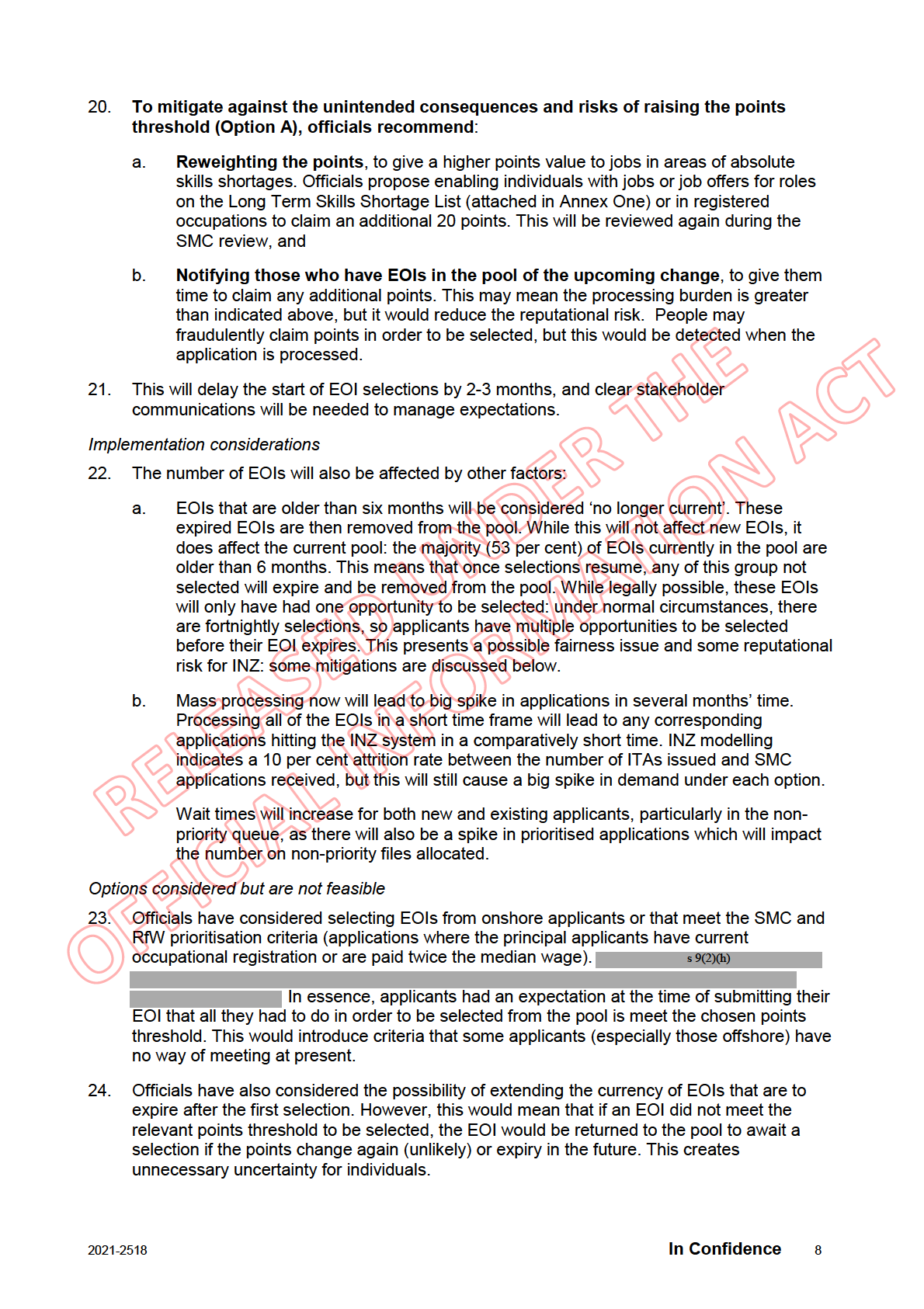
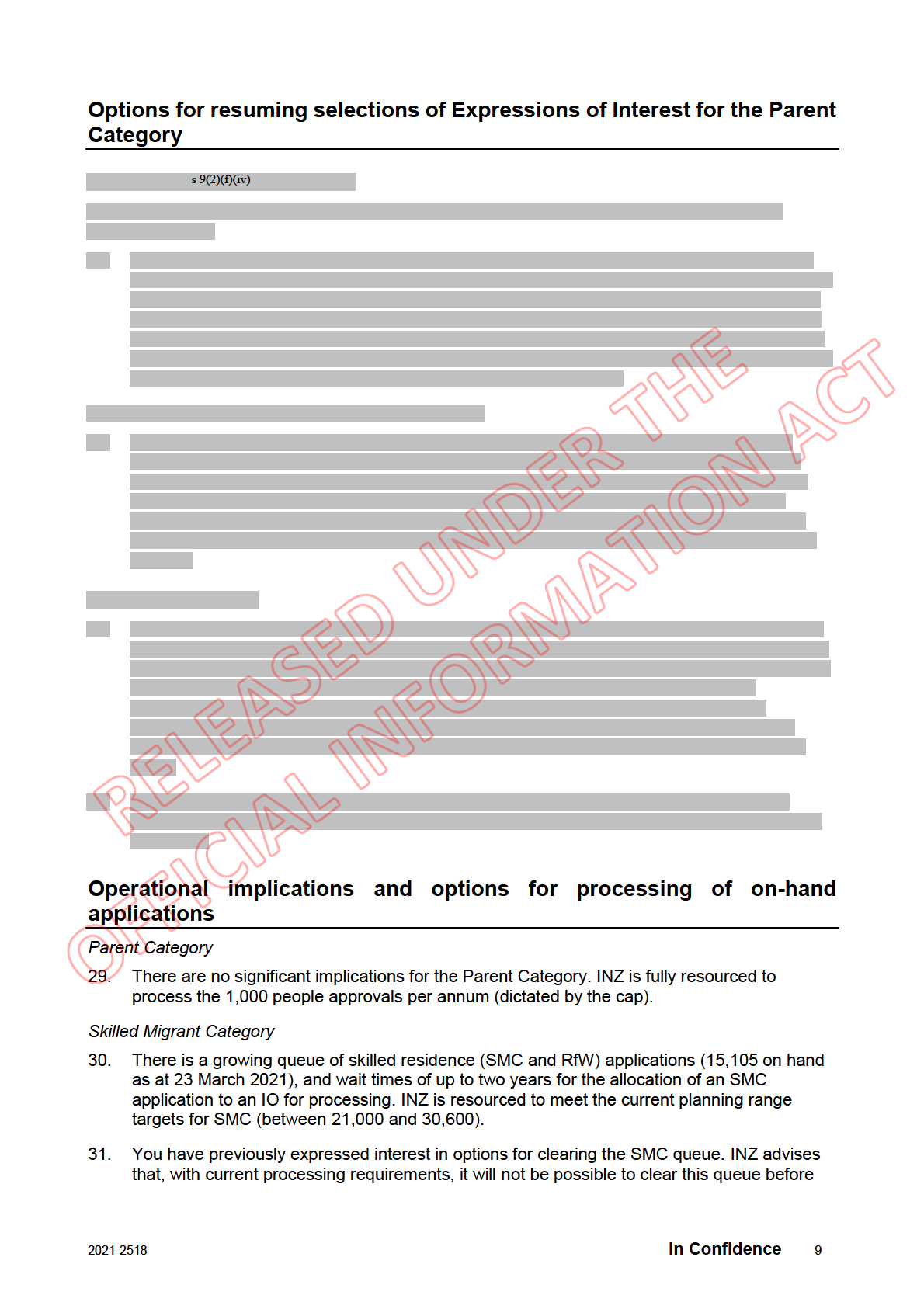

the borders reopen, assuming this is in the next 12 months. This view is informed by the
following factors:
a.
clearing the queue would take at least 310 additional staff, with challenges in sourcing,
training and accommodating new staff. INZ estimates it would take over 12 months to
scale up to this degree, and
b.
other significant change programmes happening simultaneously (e.g. the ADEPT
project and changes to the offshore footprint) which impact on the onshore processing
network.
32. INZ has developed some scenarios and options for clearing the queue which use a range of
assumptions, including:
a.
all currently on-hand applications are to be cleared to a point where INZ is allocating
applications with 2-4 weeks of receipt
b.
all 8,215 on-hand EOIs are selected;
c.
EOIs are processed at an increased points threshold of 180, resulting in around 3,300
of these EOIs becoming applications
d.
new EOIs are selected and processed at a rate of 300 a fortnight2 under a 180 points
threshold, and that RfW applications continue to be processed at a rate of 400 a
fortnight, and
e.
existing immigration instructions and standard operating procedures apply.
‘Business as usual’ scenario
33. With current resources dedicated to SMC (85 FTE) and processing to planning range of
21,000 to 30,600, INZ will not be able to clear the SMC application queue. It will continue to
grow, if demand resumes at pre-COVID levels.
Reprioritisation scenario
34. INZ have explored options for repurposing current staff to process SMC queues, but this is
not recommended as this will be a long-term shift with significant impact on service levels for
other areas of business (e.g. temporary work visa processing).
35. For example, if INZ were to reprioritise 100 staff to work on SMC, this would require, for
example, a significant portion of the IOs that process work visas across New Zealand to be
transferred to this work stream.
Upscaling scenario:
36. INZ estimate that following new staff are required to clear the SMC queue down to
mathematical zero within 12, 24 and 36 months, under the above assumptions (including a
points threshold increase to 180):
315 IOs and 45 Verification Officers (VOs) to clear in 12 months
167 IOs and 24 VOs to clear in 24 months
135 IOs and 19 VOs to clear in 36 months
2 This assumes a 50% decrease in the flow of EOI submissions under a 180 point threshold, compared to a
160 point threshold. This is a tentative estimate only.
2021-2518
In Confidence
10

37. To bring the application queue down to a point where it is in flow (estimated at 5000 on-
hand) and with an unallocated wait times of three months or less, INZ estimate that the
following new staff are required:
224 IOs and 31 VOs to reduce to this point in 12 months
142 IOs and 22 VOs to reduce to this point in 24 months
120 IOs and 19 VOs to reduce to this point in 36 months
38. This is the number of staff required for surge capacity to reduce the on hand volumes down
to zero or to 5,000: only 86 staff will be needed to maintain expected inflows and thus on
hand levels once they are reduced. Note, these staffing numbers do not include the enabling
staff that will also be needed to support these new hires, for example, managers, technical
advisors and support functions.
39. Pre-COVID, approximately 23 per cent of SMC applications were referred to offshore Risk &
Verification teams for advice or advanced verification. INZ notes that, as some offshore Risk
& Verification offices are currently closed, this wil impact INZ’s ability to effectively process
SMC applications.
40. INZ estimate that this level of new staff would be partially funded by fees, some of which
have already been received for the applications on hand, but additional Crown funding would
be required. Very early estimates suggest $30 million as a minimum, with further work
needed to fully cost this. Budget funding has been sought for 2021/22 but this assumed
processing for residence visas will continue at levels to meet the processing target, and does
not account for this upscaling in staff.
41. There will be minimal trade-offs in terms of service quality for other parts of the business
from upscaling, but there will be property needs that to meet for new staff, as well as
substantial recruitment and training needs of both new IOs and staff to support them. INZ
estimate that recruitment and training of new IOs will take up to 12 months, and up to 6
months for new Risk and Verification staff.
Next steps
42. Officials would like to discuss this briefing with you, either at Monday’s officials meeting or at
a separate time. Once we understand your preferences, a paper outlining how your preferred
changes will be implemented will be submitted to your office, with draft instruction changes
and communications material for your consideration.
Annexes
Annex One: a copy of the Long Term Skills Shortage List
2021-2518
In Confidence
11
 Annex One: a copy of the Long Term Skills Shortage List
Annex One: a copy of the Long Term Skills Shortage List
2021-2518
In Confidence
12













